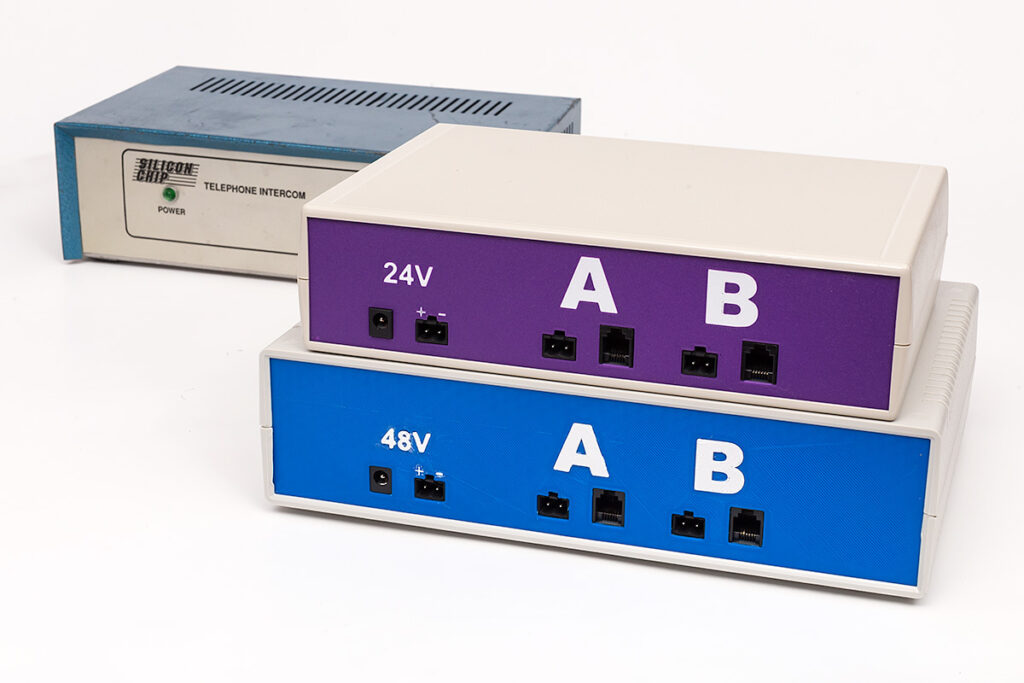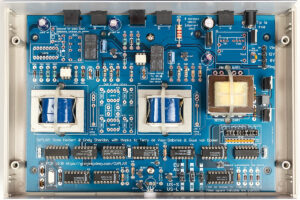My original telephone intercom project was published in Silicon Chip magazine here in Oz in May 1992. Photocopies of that original article are still available from Silicon Chip, and they kindly let me re-publish the circuit here.
The intercom unit powered two telephones, allowing you to talk between them. Lifting one handset automatically started the other ringing, and cradling both devices resets it.
Applications were the obvious “batphone” intercom between two locations, whether those be neighbours down a country road, or from the main house to the granny-flat. Service people could use it to test and repair telephones, telephone collectors used it to make static displays more interactive, and it saw use on stage and screen where a phone was required to ring on set. In a corporate environment it could be used to couple two phone systems or telephony gateway devices that only had FXO interfaces, or turn an FXO port into an FXS one. I’ve used it personally to make a “phone call” between my modem and our home burglar alarm, allowing me to reprogram the latter from within the building.
With the PCB long out of “print” [RIP Bob Barnes] I was contacted by Ross Herbert in Perth last year, with the upshot being these two old Telecom technicians spent the ensuing 18 months redesigning it. Thus OzPLAR came to be.
“OzPLAR” adds a parochial prefix to the acronym for Private Line Automatic Ring-down, which is an industry term for what a circuit like this does. If you’re even older than my 55 years, you might also be familiar with the term “QD relay set”, another equivalent from a generation or two prior.
In a deliberate move to anchor the updated analog intercom to its period in history, there’s no microcontroller here. The logic is implemented entirely in 4000-series CMOS ICs, and eschews tiny surface-mount components.
Improvements over the original design are many, although if you compare the two circuits, the original logic engine is largely unchanged.
New features include:
- superior audio performance over longer/mismatched lines (with the IC-based battery feed – see below)
- on-board jumpers (or external switch) to select AU/NZ/UK, EU or two variations on the US cadence
- support for bespoke cadence creation (optional)
- crystal-locked source for the cadence generator and ringing inverter requires no user-adjustments
- a 20Hz ringer supply for improved ringing of mechanical bells
- the calling party hears a ring-back tone, confirming the far-end is being rung
- it’s safer: powered from a 24VDC inline power supply, there’s no mains wiring involved in the build
- being 24VDC, it can be run on 2 x 12V batteries for an off-grid, portable or temporary setup
- everything mounts on one double-sided PCB
- designed for a global audience using only commonly-available components, with the PCB accommodating many variations to cater for the global supply chain
- choice of iron-core or solid-state battery feed
- reversal on answer for testing or demonstrating public (aka coin) telephones (optional)
- support for 48V DC power input (optional)
Battery feed
The original battery feed design has been improved by using two transformers. This improves the audio performance as the higher impedance to speech couples more power to the line and shunts less speech to ground through the supply.
The PCB pattern accommodates the Altronics (AU) M1000, as well as the globally-available Triad TY-305P, TY-306P and TY-400P. The Altronics M1010 and Tamura TTC143-LB are also suitable, but will need to be mounted up-side down on the board via a cable tie and wired with flying leads.
The 8-pin Lucent LB1011 solid-state battery feed IC is long obsolete, but good stocks are still available online. Built in this variant the OzPLAR could be built for $30-50 cheaper than equivalent iron-core components, and with superior performance into disparate lines as each telephone gains its own self-contained battery feed. Read more about that on the ‘customisation’ page.
| Manufacturer | Model | Supplier | Inductance (series) | Unit cost ($AU) | Suitability/performance |
|---|---|---|---|---|---|
| Lucent | LB1011 | Digipart/Octopart | n/a | $2.00 | Ideal |
| Triad | TY-305P | Mouser | 3.6H | $19.19 | Ideal |
| Triad | TY-306P | Mouser | 3.6H | $30.28 | Ideal |
| Triad | TY-400P | Mouser | 1H | $8.39 | Acceptable |
| Tamura | TTC-143-LB | Mouser | $15.41 | Acceptable | |
| Altronics | M-1010 | Altronics | $13.95 | Acceptable | |
| Altronics | M-1000 | Altronics | 1.4H | $13.95 | Acceptable |
| Tamura | TTC-5029 | Digi-Key | $11.40 | Unacceptable | |
| Tamura | TTC-5017 | Digi-Key | $9.27 | Unacceptable | |
| Triad | TY-146P | Element14/Farnell | $15.32 | Unacceptable |
Power
By default OzPLAR accepts a 24V DC input, and this rail directly powers the battery feed. Whilst analog telephony traditionally uses 48V, NEC PABX’s and Telecom Australia’s (Telstra) intercoms such as the Intercom System 1 + 2 have used 24V going back more than 50 years without compromising performance, and we’ve adopted this same model.
A switch-mode regulator steps the 24V down internally to provide a 12V rail for the CMOS logic and the ringing inverter. Current drawn from the 12V supply is generally negligible, peaking only when a phone is ringing, however this precluded the user of a linear 7812 regulator (although with some heatsinking you’ll probably get away with it). The 7812 has internal over-temperature protection and will simply shutdown if it gets too hot. Switch-mode 7812 equivalents won’t require a heatsink.
If you’re building for 48V DC operation you can omit the 12V regulator and replace it with either a MeanWell SKMW06G-12 (Mouser) or Traco TMR 6-4812 (Digi-Key). These modules have a much higher headroom than the 7812, accepting up to a 75V DC input.
Global sourcing
We’ve designed the circuit and PCB to accommodate components from all the large component suppliers, including Digi-Key, Element14/Farnell, Mouser and RS, as well as Altronics here in Australia.
In this image are all the power transformers deemed suitable to generate the AC ringing supply, and for which we’ve accommodated on the PCB. From L-R are the Altronics M7024A, Tamura 3FD-324 (Mouser & Digi-Key), Vigortronix VTX-120-003-612 (Element 14/Farnell), Vigortronix VTX-120-3803-412 (RapidOnline) & the RS 504-464.
Cost
The cost to build the OzPLAR will vary depending on where you are and the version of battery feed you choose to implement.
Our estimates for the component costs (including PCB and enclosure, but excluding the 24V supply & 3D panels) run to around $AUD150, approx. $USD110 and EUR92. There’s some variation here depending on the battery feed transformer chosen/available to you. Further savings can be made by omitting some components (like the duplicated telephone and power sockets), and if you’re hard-wiring for Euro or one of the US cadences, you can omit the 4078, a 1N914, the resistor network and related headers. A table of optional components will be published in due course.
Availability
The PCB, circuit and full documentation are in the October 2021 issue of Silicon Chip magazine. Silicon Chip is also selling the PCB.
The artwork for the custom 3D printed panels can be found on Thingiverse. There are separate .stl & .3mf files for Altronics and PacTec enclosures, with your choice of 24V and 48V voltage rating labels.
Credits
Ross and I collaborated on the design, with my partner OzRocky providing the 3D prints for the PacTec case panels.
OzPlar incorporates a variation on the 20Hz ringer from Terry de Vaux-Balbirnie’s “Phone Ring & Test” circuit, published in Everyday Practical Electronics magazine in June 2006. We thank Guus van Baalen for sharing his updated circuit with us.
Revision History
11th October 2021: updated the main image.
27th September 2021: this is the initial release.
– G.









Hi Greg,
I’ve built you telephone intercom described in Silicon chip and it works very well. Thanks for publishing it.
Regards
Dale Hughes
Thanks Dale, I’m glad you liked it.
I’m curious to know what you’re using it for, and if you’re using any of the many extra features we added in this redesign?
– Greig.
Hi Grieg,
I am in the process of building my OzPLAR and I would like to add the reversal circuitry in case I acquire a payphone down the track, but does the reversal circuit only work with payphones and not regular phones as well? I will be initially using the OzPLAR with conventional phones (the mechanical type that was in use in 1984) as an intercom between our guest room and main house – the old style phone is there as a nice functional antique that makes for a good talking point.
Thanks,
Matt
Hi Matt,
I’m pleased to see someone else is finding a use for OzPLAR, as well as the ROA (Reversal On Answer) feature, which was a late inclusion into the design. Don’t worry about using this with ordinary phones as they’re not polarity sensitive.
Let me know how you go, and hit me up if you encounter any problems with it.
– Greig.
Hi greig!
I am wanting to build the kit that will allow the use of 2x telecom touchphones from the 80s, I just want it for the shed as a bit of fun to relive the old days of the old phone ring sounds!
Where can I buy the kit/ components? There is definitely a market for this type of thing especially amongst the now 50 year olds that have man caves and want the old school memories.
Regards Jase
Hi Jase,
Unfortunately the kitsets we knew in our youth are largely a thing of the past. To my knowledge no-one’s keeping kits of OZPLAR, but most of the components are standard Jaycar or Altronics lines here in Oz, and we’ve deliberately searched for multiple suppliers of the esoteric bits to make sourcing them as easy as possible. (All of that is documented in the magazine article, but you see it referenced in this post re the battery feed transformers.)
You should be able to assemble a DIY kit with a mouser order, and take advantage of their free shipping once you hit AUD$60. The PCB you can get directly from Silicon Chip.
Let me know if you encounter any problems.
– Greig.
OzPLAR (Oz Private Line Automatic Ring-down)
What is exactly the meaning od “Oz” in this name?
Hi Mariusz,
It’s because the two creators are Australian, and we often use “Oz” as an abbreviated reference to our country. So it’s an “Australian-designed Private Line Automatic Ring-down” device.
:-)
Greig.
Thank You for the explanation :-) Now it’s clear :-)